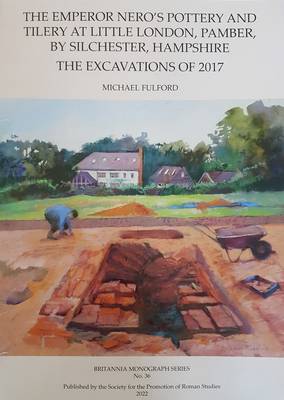
- Retrait gratuit dans votre magasin Club
- 7.000.000 titres dans notre catalogue
- Payer en toute sécurité
- Toujours un magasin près de chez vous
- Retrait gratuit dans votre magasin Club
- 7.000.0000 titres dans notre catalogue
- Payer en toute sécurité
- Toujours un magasin près de chez vous
The Emperor Nero's Pottery and Tilery at Little London, Pamber, by Silchester, Hampshire
The Excavations of 2017
Michael Fulford
Livre broché | Anglais
50,45 €
+ 100 points
Description
Previously suspected on the basis of a tile stamped with the name and titles of the Emperor Nero found alongside other brick and tile in the ploughsoil, excavation of two tile kilns at Little London near Silchester, Hampshire confirmed production during the reign of Nero. In addition to the manufacture of standard bricks and roofing materials, the kilns produced the more specialist materials required for building bath houses. Work on the fabrics and distinctive, roller-stamped flue-tiles show that products reached a wide variety of destinations between Cirencester, some 100km to the north-west, and Chichester, on the south coast, though Silchester appears to have been the main market and is the only location where Nero-stamped tile has so far been found. A suggestion is made linking the stamped tile to the visit to Britain by the emperor's trusted freedman, Polyclitus in the aftermath of the Boudican revolt. An unexpected discovery was the ancillary production from at least three pottery kilns of a wide range of pre-Flavian domestic wares, so far only identified in Silchester and its environs. Alongside the publication of the kilns there are illustrated catalogues of the complete range of brick and tile types produced as well as of the pottery. Other reports include analysis of the fuels used and a suite of radiocarbon dates which support the pottery evidence for production ceasing in the early Flavian period. Analysis of the numerous animal foot-impressions on the bricks presents one aspect of the environment of the kilns.
Spécifications
Parties prenantes
- Auteur(s) :
- Editeur:
Contenu
- Nombre de pages :
- 218
- Langue:
- Anglais
Caractéristiques
- EAN:
- 9780907764502
- Date de parution :
- 20-04-23
- Format:
- Livre broché
- Format numérique:
- Trade paperback (VS)
- Dimensions :
- 201 mm x 273 mm
- Poids :
- 925 g

Les avis
Nous publions uniquement les avis qui respectent les conditions requises. Consultez nos conditions pour les avis.






